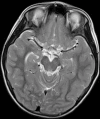Spontaneous Resolution of Pharyngeal Myoclonus in a Child: An Uncommon Case With Objective Clicking Sounds
- PMID: 40926913
- PMCID: PMC12415406
- DOI: 10.7759/cureus.89518
Spontaneous Resolution of Pharyngeal Myoclonus in a Child: An Uncommon Case With Objective Clicking Sounds
Abstract
Pharyngeal myoclonus is a rare movement disorder characterized by rhythmic pharyngeal contractions, typically reported in adults with neurological lesions and rarely in children. We report a seven-year-old girl who experienced involuntary clicking sounds localized to the right ear. Nasopharyngoscopy revealed pharyngeal myoclonus without structural abnormalities, and brain and laryngeal MRI were unremarkable. No intervention was performed, and symptoms resolved spontaneously over 12 months, coinciding with increased familial support in response to suspected psychosocial stress. This case highlights the benign, self-limiting nature of pediatric pharyngeal myoclonus and suggests that conservative management may be appropriate, particularly when environmental or psychological factors are the suspected contributors.
Keywords: functional movement disorder; pediatric case; pharyngeal myoclonus; psychosocial stressors; spontaneous resolution.
Copyright © 2025, Yokoyama et al.
Conflict of interest statement
Human subjects: Informed consent for treatment and open access publication was obtained or waived by all participants in this study. Ethics Committee of the Japanese Red Cross Wakayama Medical Center issued approval 1507. This case report was reviewed and approved by the Ethics Committee of the Japanese Red Cross Wakayama Medical Center (approval number: 1502). Written informed consent was obtained from the patient’s parents for publication of this case report and accompanying audio and video materials. Conflicts of interest: In compliance with the ICMJE uniform disclosure form, all authors declare the following: Payment/services info: All authors have declared that no financial support was received from any organization for the submitted work. Financial relationships: All authors have declared that they have no financial relationships at present or within the previous three years with any organizations that might have an interest in the submitted work. Other relationships: All authors have declared that there are no other relationships or activities that could appear to have influenced the submitted work.
Figures


References
-
- Four new cases of progressive ataxia and palatal tremor (PAPT) and a literature review. Silimon N, Wiest R, Bassetti CLA. https://www.mdpi.com/2514-183X/7/4/32 Clinical and Translational Neuroscience. 2023;7:32.
-
- Frequency, phenotypes, and neuroimaging of early post stroke movement disorders: a prospective study. Samra E, Roushdy T, Zaki AS, Mansour AH, Elbassiouny A, Shalash A. The Egyptian Journal of Neurology, Psychiatry and Neurosurgery. 2025;61:0.
-
- Symptomatic and essential palatal tremor. 1. Clinical, physiological and MRI analysis. Deuschl G, Toro C, Valls-Solé J, Zeffiro T, Zee DS, Hallett M. Brain. 1994;117:775–788. - PubMed
-
- Essential palatal myoclonus. A pediatric case report (in Spanish) Spini R, Cohen D, Juchli M, Ibarra L. Arch Argent Pediatr. 2021;119:0–7. - PubMed
Publication types
LinkOut - more resources
Full Text Sources
